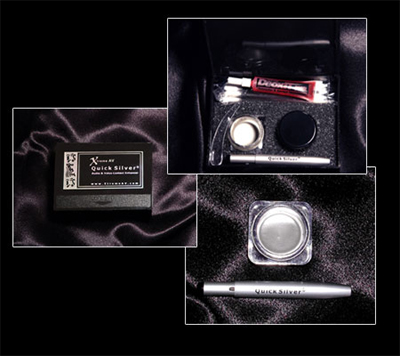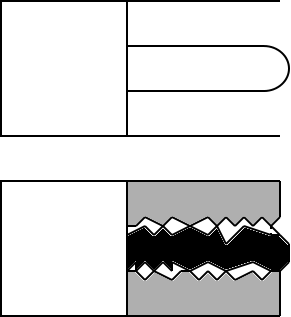|
You are reading the older HTML site
Positive Feedback ISSUE
17
Xtreme Cables' Quicksilver Contact Enhancer
Ah, the wonderful world of tweaks! Everything from “room lenses” to sandboxes to magic dots to “chemical enhancers” like Auric Illuminator. (When I was younger, the term “chemical enhancers” had a different meaning, but that’s another story.) The realm of tweaks is fraught with junk science, personal preferences, even some religion. I know of a guy who tells you to write “good” on a CD to make it sound better! Surely this is a region of audioland that sensible reviewers stay away from, but a tweak has come along that actually makes perfect sense to me. Quicksilver Contact Enhancer is designed to improve the conductivity of all of your electrical (power and signal) connections. Is this necessary? Is it something you really want to do? Read on. Audio systems are mostly compromises. The most efficient component is wasting at least fifty percent of the energy involved. Class “A” amplifiers are the worst, but even CD players must handle error rates in reading the pits on cheap aluminum discs. Power supplies convert only a fraction of the energy put into them to drive the component. You know what the real killer is? Even the most expensive components have the same efficiency as a $30 DVD player! In fact, that $30 DVD player is probably more efficient, because the designer couldn’t afford any luxury.
The RCA connector is one of the worst electrical signal connections in existence. Discounting the cheap construction of the average connector, another problem is the surface area. If you were to examine the metal surface of any connector under a microscope, at say 200X (see above), you would be shocked to learn it isn’t smooth. In fact, it’s so rough that less than half of the connector surface actually makes contact! (See the drawing below for a typical cross section of an RCA plug and mating jack.) That’s where the Quicksilver Contyact Enhancer comes in. It is a solution of pure silver which, when applied in a thin paste to connector surfaces, fills in gaps and improves conductivity. Even better, Quicksilver is not just a solution in a bottle but an entire “system” that includes a de-oxidizer and an application brush. And get this—it’s not just for audio connections but for every single electrical connection of any kind. Start with the power plug, the fuse holder, and the tube pins. Go from there your audio connections, then your video system. There is enough solution in the bottle to keep a dedicated tweaker busy for weeks.
I guess it’s time to ask the obvious question: Does it work? I found out that there are many, many connections in the average audio and home entertainment system. It took me an entire day just to do my video connections. I counted over 48 between the cable RF, component video, SVHS, and audio for my three televisions, plus cable boxes, DVD players and TIVOs. Some of the applications required are not for the faint of heart. The connectors are tiny, and you do NOT want to get the Quicksilver across any connectors and short them out. It is conductive when it dries. Luckily it cleans very easily with alcohol, but I did have problems with SVHS pins, so take your time and be careful. I started with my DVD player and its component video connectors (three on each end) for a quick evaluation. I saw an instant improvement. Colors were brighter and more saturated. I am certain that some of this improvement was due to simply cleaning the connections, but later that evening I saw even more improvement in clarity, probably because the Quicksilver solution had dried. The following day I decided to do all my cable TV connections. There was a slight but noticeable improvement. I didn’t think much about it until the following weekend, when several friends and relatives visited for dinner. Everyone commented on the TVs, and I had to admit that the improvement was startling by then. I actually had to turn down the brightness and color on my 56-inch RPTV because it was so bright! The picture was more three-dimensional than before. When I popped in Diana Krall’s Live in Paris DVD for a quick check, the picture was amazing. Over the following week, I noticed that programs recorded on my TIVOs were also exhibiting superb clarity, brightness, and purity of color. I watched a few programs that had been recorded previous to the Quicksilver application and a few that had been recorded after. The difference was obvious. The older programs were dull, visually noisy, and flat, while the newly-recorded shows were vivid and crystal clear. I again attributed the gradual improvement to the drying of the Quicksilver liquid. There may even have been some molecular action going on, but who knows? I’ve written a lot about video, but what about audio? That’s a tougher call, as it’s much harder to quantify. There were subtle improvements, but they were very cable dependent. Also, each time I changed cables to hear the differences, I had to clean the Quicksilver from both the component and the cable. Even then, I doubt the Quicksilver was completely removed. I’m sure that the silver leaks into pores in the metal and never comes completely out. Nevertheless, I can testify that the solution never decreases the sound quality, but yields a subtle but noticeable improvement over time. The range seems to be several hours to as long as two weeks. Quicksilver-treated connections are meant to stay connected, so disconnecting the cable means reapplying the solution and waiting. During the course of a month, I did this many times, trying to juggle my notes and opinions of interconnects, speaker cables, and power cords. There was no question that the Quicksilver solution improved interconnects and speaker cables the most. In conclusion, I would say that the Quicksilver Contact Enhancer kit is a great value at $72. I cleaned at least eighty connections, and still have plenty left. This has been one of the most time-consuming and complicated reviews I’ve done, and I foresee spending still more time as I audition Xtreme’s audio cables with and without the Quicksilver treatment, but what the heck—it’s fun! Ed Morawski
Xtreme AV
|



